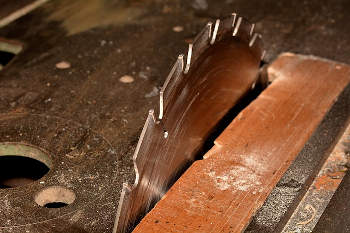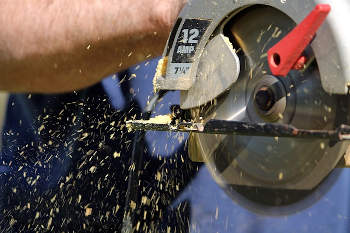Determining When it’s Time to Sharpen or Replace a Dull Saw Blade

What can tell you that your saw blade is dull? You might wait for your car to tell you when it’s due for an oil change. Maybe you change the oil every 3,000 or 5,000 miles. But your saw will not send an alert to your cell phone to notify you that the blade is worn out. There aren’t automatic notifications, or a set number of uses to tell you when it’s time to replace your saw blade. You make that determination using your own good judgment.
It doesn’t matter if you use your saw every day, or only a few times a year; eventually the blade wears down to a point where it needs sharpening or replacement.
Page Contents
Factors That Determine a Saw Blade’s Lifespan
Many variables affect the effective cutting life of your saw blade. The main factor is how often you use your saw. If you use your saw every day, the blade will need replacement quicker than if you use it only once or twice a month. This is pretty straight forward and everyone understands it.
One more factor is the hardness of the material you are cutting. Cutting hardwoods will wear your blade out much quicker than cutting softwoods. Hardwoods are much tougher on the carbide teeth of the saw blade. For comparison, cutting metal pipe will wear a blade out faster than cutting PVC pipe. It’s the same principle for hardwoods and softwoods.
Another factor is blade quality. A high-quality blade will cut effectively and accurately for a longer period vs. a bargain blade. A high-quality blade can be sharpened multiple times. Whereas a bargain blade might not even be worth sharpening, and replacement with a new one is a better option. Here is a guide explaining the benefits and differences between high-quality and bargin saw blades.
How to Tell if Your Saw Blade is Dull or Worn Out

If your saw blade has been cutting fine, and you have noticed no changes in how it cuts, then it’s likely that you’re still working with a sharp blade. A dull blade will not operate the same as when it was new, but sometimes it can be hard to tell.
Some noticeable things that should stand out when cutting with a dull blade:
- Increased tearout and chipping when making cuts. As the blade becomes dull, it causes more tearout and chipping. A sharp blade makes clean cuts because it slices through the wood fibers. A dull blade instead tears and breaks them, causing tearout and chip out. If you are seeing tearout after every cut, then the blade is most likely worn down.
- Burn marks that were not happening before on similar cuts. Burn marks are common, but they are also a good indicator of a worn-out blade. A dull blade needs more time and force to advance through a cut. This leads to increased friction with the workpiece that creates burn marks.
- More resistance when making a cut. You should notice if cutting is becoming difficult to advance through the workpiece. You should feel little to no resistance when pushing through a cut with a sharp blade. If the blade feels like it needs more force than when it was new, or it seems to get bogged down at certain spots while cutting, it might be dull. When using a table saw, simply sliding the workpiece across the saw’s tabletop and through the blade should be all the effort needed.
- Difficulty trying to follow cut lines. Dull blades do not move smoothly along cut lines. When a saw blade is dull, it needs more force to cut through the material. The blade wants to follow the path of least resistance when it’s dull. This leads to inaccurate cuts. If your cuts are jagged or imprecise, then that is a sign that your blade might be worn out.
- The saw motor is becoming louder while making cuts. You drive your car every day and you know the usual noises that it makes if you hit a bump, or if your brakes a getting low. But if your car makes a different noise, then you get worried that there might be a problem. The same goes for your saw. If you use it often, then you become familiar with what sounds it makes during cuts. If the sound changes, or it sounds like the motor is straining when making a cut, then that might be a sign of a dull saw blade.
These are all red flags that are telling you it is time to replace or sharpen your saw blade. But it could also mean that your blade might need a cleaning. Sometimes cleaning your saw blade will make it cut like new again.
Does Your Saw Blade Need to be Cleaned?

Poor cutting is often a result of a dirty blade. Sometimes your saw blade will show all the characteristics of being worn out, but all it needs is a good cleaning to get back to cutting like new. Resins from lumber stick to the saw blade while cutting. They gum up the cutting edge on the teeth. After accumulating enough residue on the saw blade, it causes the characteristics of a dull blade to appear.
How to Clean Your Saw Blade
Cleaning a dirty saw blade is easy, and a good way to get it to cut like new again.
- Soak the blade in Simple Green or another all-purpose cleaner for 15-20 minutes. Simple Green is one of the best cleaners for cleaning residue from saw blades. It’s strong enough to remove residue, but not too strong to be a potential health hazard.
- Brush it with a nylon or plastic bristle brush- a toothbrush works well. Focus mainly on the teeth but give all surfaces at least a once over.
- Rinse the blade off with plenty of water, and dry it off completely to prevent rusting.
After completing these steps, put the blade back on your saw and perform a test cut to check if it’s cutting ability has improved. If cutting hasn’t improved, then the blade needs sharpening or replacement.
Precautions to Take When Cleaning a Saw Blade
Some commercial saw blade cleaners are very strong on the pH scale. They are strong bases, not acids, but that does not mean that they can’t cause the same health hazards as a strong acid.
Strong bases are caustic. Some commercial saw blade cleaners are extremely caustic. They are formulated strong enough to be able to clean blades quickly but they also degrade brass, copper, and aluminum quickly. Other metals do not degrade as fast. If you’re unsure of the material your saw blade is composed of, err on the side of caution.

Rinse off the blade with plenty of freshwater when cleaning with highly caustic cleaners. You should always wear gloves when handling chemicals. But make sure you are wearing chemical resistant gloves when cleaning a saw blade using a commercial saw blade cleaner. This will prevent chemical burns and hazardous reactions to your hands and skin.
It is also a good idea to wear nose, mouth and eye protection while cleaning with a commercial cleaner. Tiny droplets of cleaner can shoot into the air in the immediate area where you are cleaning your saw blade. Those tiny droplets will be in danger of inhalation, ending up in your lungs. They can also end up in your eyes. Both of which are seriously dangerous.
How Many Times Can You Clean a Saw Blade?
There is no definitive answer on how many times you can clean your blade before it’s too dull to cut anymore. A good rule of thumb is after the 2nd or 3rd time cleaning your saw blade, it’s time to sharpen or replace it. Some other factors also come into play here. If you cut a lot of wood that gums up the blade, like pine, you will probably get over 3 cleanings before sharpening or replacement. A high-quality blade may also go 3 or more cleanings before it needs sharpening, while a bargain blade might only go 1 or 2 cleanings before it needs to replaced.
Other Ways to Tell if Your Saw Blade Needs Sharpening or Replacement
Do a visual inspection of the saw blade, keeping an eye out for these potential issues:
Look for signs of wear and damage. Broken and missing teeth are obvious signs that your blade will need to replacement, since a completely missing tooth on a saw blade cannot be repaired. This is simple to spot if there’s a problem.
Check for rounded and chipped teeth. Compare the teeth to one another. If several teeth look chipped compared to the others, then it is time for sharpening or replacement. Chipping will primarily occur on the carbide tips of the teeth. Saw blade teeth vary in shape, here is a guide explaining the differences and what the teeth look like when new.

Check the carbide tips of the teeth by examining the blade up-close with a flashlight. Look down closely at the blade and reflect the light off the tips of the carbide teeth. If the tip appears to reflect the light differently from the rest of the tooth, then that is a sign that the carbide tip has broken off. Send the blade for sharpening if many of the carbide tips are missing.
Compare the saw blade to another similar blade that you know is sharp and in good working condition. Experienced woodworkers often buy more than one of the same blades. One blade works as your primary, while the other one works as your backup you use periodically. This makes it easy to tell when your primary blade is dull. You also always have a sharp blade to work with.
When you comparing the two blades, notice differences between their teeth. It is easy to determine when your primary blade is worn out if the teeth look very different from your backup. Swap your backup blade onto the saw and send out the primary for sharpening or replace it. When you get the newly sharpened blade back, that blade will become your backup. This way you always have a backup blade in good condition to compare with your primary blade.
Another Money Saving Reason for Not Using a Dull Saw Blade

You may know that your blade is getting dull, but you put off sharpening it because you want to finish a project. This is a bad idea if you are using a pricey, high-quality saw blade. You shouldn’t use your high-quality blades when you know they are worn down.
As the blade wears down, it generates more heat as it cuts. Heat is bad for the saw blade. Excessive heat will cause the saw blade to warp, and will lead to increased vibration during cuts.
This will lead to inaccurate cuts, and a bigger expense when you get your blade sharpened. Because now the warped blade will need to be flattened, as well as sharpened. When it’s time to sharpen your high-quality blade, have them sharped as soon as possible. Or at the very least do not use them. You might save yourself a few bucks in the long run.
